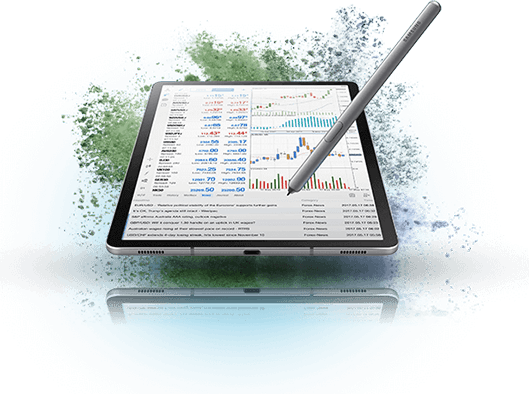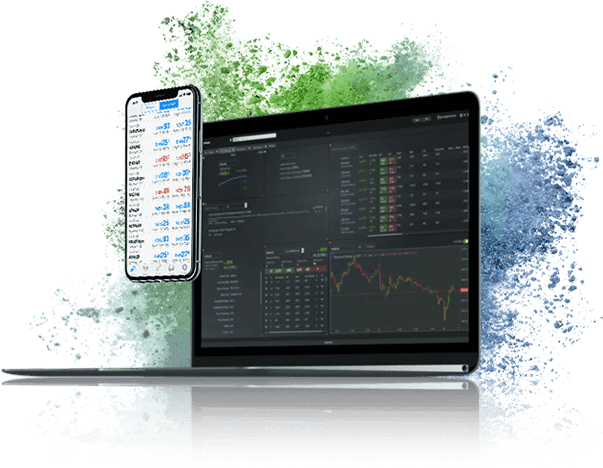Experience Trading
on the Go
on the Go
Types of
Indexes / What
are the Different
Types of
Indices?
An index is created to measure financial or economic data, like interest rates, inflation, employment level or manufacturing output. In the case of financial markets, it broadly refers to a portfolio of securities that represents a particular segment, subset, region, or industry.
For instance, the S&P500 is a portfolio of the top 500 stocks of companies trading in the American stock market. These may not be American companies per se. Several European and Chinese companies have stocks trading in the US stock market and these may be included in the index.
Similarly, the ASX200 is a portfolio of the top 200 stocks of companies trading in the Australian stock market. In the same vein, the US Aggregate Bond Index represents the US bond market. Stock indices trading is considered an attractive way of participating in the movements of the stock market without having to invest in and own individual stocks.
Global indices markets are dominated by the benchmark stock indices that have a significant impact on economies and are considered reliable indicators of the financial health of the segment represented by them. Before you embark on indices trading, it is a good idea to know what the different types of indices are, their composition, ways to trade them and the platform best suited for executing trades.
What are the Benefits
of Trading Indices?
People trade indices to speculate on the changes in their valuation. Although indices tend to be less volatile than individual securities, they do offer attractive trading opportunities. Indices trading offers the following benefits:

Since each index represents a group of securities, bonds, or commodities, indices trading offers an easier way to gain exposure to the segment a trader is interested in rather than investing in individual stocks, bonds or commodities. As most indexes relate to a broad market, a trader does not need to learn about each security and all the factors that influence their price.

Indices cannot be manipulated. Since an index comprises of not one but several stocks or assets, it is difficult for one or a handful of traders to manipulate it. To influence the price of an index, a trader would need to invest in each of its components.

Indices trading is less risky than investing in an individual stock or commodity. The inclusion of several stocks or commodities in a single index helps diversifying exposure, thereby reducing volatility. Even if the value of one stock plummets, it cannot impact the entire index of which it is a part. Also, the plummeting of one stock may be compensated by a rally in another constituent stock of the same index.

Indices are impacted by the overall industry or economic condition and do not rely solely on the performance of its component stocks.

Indices trading allows you to diversify your investment portfolio since each index comprises of several different stocks.

Unlike an individual company, an index cannot go bankrupt. Bankruptcy of an individual company means the complete erosion of your investment. However, if you have invested in a unique index, the bankrupt company’s stock will be replaced by another company’s stock, having a limited impact at best on the index.
What are the Different
Types of Indices?
Indices can be created for measuring the performance of equities, commodities, the real estate segment, bonds or even hedge funds. The different types of indices are:
Bond Indices
These indicate the total rate of return for the portfolio of bonds. They include key values such as price change, accrued interest and reinvested coupon income. Bond indices can be for government bonds, high-yield bonds, corporate bonds, and mortgage-based securities.
Commodity Indices
A commodity index is generally a fixed weight index of select commodity prices based on spot or future rates. These indices are designed to represent a broad commodity class, such as energy, grains, livestock, and metals. Such indices may track commodities directly or indirectly by tracking futures contracts based on them.
Real Estate Investment Trust Indices
A unique index type that tracks the performance of the real estate segment and publicly traded REITs (real estate investment trusts).
Hedge Fund Indices
As the name suggests, these indices track hedge funds.
Equity Indices
When one talks about indices trading or indices in financial markets, they are usually referring to stock market indices that measure the value of a certain segment of the stock market. These indices help investors analyse the overall conditions in a particular market and to compare different investments.
Equity indices can be global, regional, or national, depending on the kind of stocks they cover.
Global Stock Market Indices: These indices track equities from across the world. For example, the MSCI World Index tracks large and medium cap stocks from 23 developed countries. Other examples are the S&P Global 100 index and the Dow Jones Global Titans 50.
Regional Stock Indices: These track stocks from specific regions, such as Asia, Europe or Latin America. These indices allow investors to compare the performance of specific regions. Examples of such indices are the S&P Asia 50 index, Euro STOXX 50 index, and S&P Latin America 40 index.
National Stock Market Indices: These provide exposure to individual nations. Examples include the Dow Jones Industrial Average, FTSE 100, Nikkei 225, CAC40 and ASX200.
Apart from the segregation of indices based on the region they cover; several other specialised indices exist. For instance, the Dow Jones Islamic Market World is meant for investors adhering to Islamic laws.
There are also certain sector specific indices that measure the performance of a specific market segment, such as biotechnology, energy or consumer durables. These indices are used to track the performance of specific segments of an economy.

What are the Leading
Stock Market Indices?
Stock market indices
are widely traded because they are powerful indicators of the health of the global and
country
specific economies. The price of most indices is calculated by one of the following two methods:
Market Value
Weighted Indices
The value of market value weighted indices is calculated on the basis of the total market value or capitalisation of its component stocks. This means that the bigger companies have a larger impact on the value of the index. The value of most indices based on this valuation method is calculated by considering only the shares that are readily available in the market and not all shares. Shares that are locked or held by insiders, promoters and governments are not considered.
Price Weighted
Indices
The calculation of price weighted indices takes into account the individual share prices of their constituent stocks. This means that companies with higher share prices have a stronger impact on the overall value of the index.
Here is a list of the some of the most popular
indices traded in the
form of CFDs and via exchange traded funds (ETFs):
ASX200
This is a market capitalisation weighted, float adjusted index. It comprises of 200 stocks listed on the Australian Securities Exchange. Maintained by Standard & Poor’s, this index is the benchmark for the Australian equity market, with its constituent stocks accounting for more than 80% of the Australian stock market capitalisation. The index is rebalanced every quarter and its value changes only when the prices of its constituent stocks change. At times, the market capitalisation of a stock may change due to share buybacks or stock splits. This, however, has no impact on the index, unless those events cause a fluctuation in the share price. A stock’s weight in the ASX200 is determined by its market capitalisation adjusted for the float and its trading volume.
DOW30
Also known as the Dow Jones Industrial Average, this stock index is one of the most popular among traders, largely because it comprises of stocks of the 30 largest publicly traded companies in the United States. The value of this index is calculated as the sum of the share prices of the companies included in it divided by a certain factor that is adjusted on the basis of stock splits and stock dividends. This index is a good indicator of the general health of the US economy.
Eligibility norms for the inclusion of a stock in this index include sustained growth and excellent reputation, besides the company being incorporated and headquartered in the US.
EURO STOXX50
This stock index comprises of Eurozone based stocks but is largely dominated by stocks from France and Germany. The index was designed by STOXX, part of the Deutsche Borse Group, and includes 50 large and liquid stocks of the euro area. The composition of the stocks is reviewed every year and it is available in several currency and return options. The calculations for this index are done every 15 seconds for the USD and EUR variants, while for the JPY, GBP and CAD variants, calculations are made only at the end of the trading day. A highly traded and most liquid index for the euro region, this index is one of the top stock indices in the world.
CAC40
Represents the French stock market and comprises of 40 of the most important stocks listed on the Euronext Paris. Like all other indices, the composition of this index is based on free float market capitalisation. Reviewed every quarter, the composition of this index is altered according to the ranking of the companies on the basis of their free float market capitalisation and share turnover in the previous 12 months. An important feature of this index is that the constituent companies are multinationals conducting a significant portion of their business outside France.
DAX30
German stock index that was created in 1988 and its constituent companies represent 75% of the total market capitalisation on the Frankfurt Stock Exchange. The index tracks the performance of the 30 largest companies in France, including Volkswagen, Bayer, Adidas and BMW. These stocks influence not only the domestic German economy but also the global economy. Reviewed every quarter, the DAX30 includes only those companies whose shares have a minimum free float of 10%, operating headquarters in Germany and the company is listed in the Prime Standard Segment for companies meeting stringent transparency rules.
Although changes to the list of stocks included in the DAX30 are made on regular review dates, members can be removed if they don’t rank in the top 45 or be added if they reach the top 25 list.
Hang Seng 50
This stock index measures the overall performance of the top 50 Chinese companies in terms of market capitalisation (free float adjusted), listed on the Hong Kong or mainland China stock exchanges. Compiled and maintained by a subsidiary of the Hang Seng Bank, the constituent companies of this index represent about 58% of the total market capitalisation of the companies listed on the Hong Kong stock exchange. Stocks of only those companies are selected for inclusion in the index which have significant market value, turnover, and good financial performance, besides a consideration of the sector they belong to.
Nikkei 225
This stock index represents the stocks listed on the Tokyo Stock Exchange. The value of this price weighted index is calculated daily by the Nikkei newspaper, which it has been doing so since 1950. Reviewed once a year, the constituents of this index belong to a wide range of industry segments. From January 2010 onwards, the index is updated every 15 seconds during the trading sessions.
S&P500
One of the most traded indices, the S&P500 measures the stock performance of 500 large companies listed on the US stock exchanges. This capitalisation weighted index includes some of the biggest names like Apple, Microsoft, Amazon, Facebook, Alphabet, Berkshire Hathaway, Johnson& Johnson, JPMorgan Chase, and Visa, which are listed in the US, but derive a significant proportion of their revenues from outside the country.
The components of this index are selected by a committee on the basis of market capitalisation, liquidity, domicile, public float, global industry classification standard, financial viability, length of time that the stock is being publicly traded and the representation of the industry in the US economy.
FTSE100
Maintained by a subsidiary of the London Stock Exchange, this index consists of 100 top companies listed on the LSE on the basis of their market capitalisation. The index is calculated real time and published every second during the market open hours. A large proportion of the constituent companies are internationally focused, making the index movement a weak indicator of the US economy’s progress. The index is, therefore, significantly impacted by the exchange rate for the British pound. Requirements for inclusion in the index relate to nationality of the company, free float, and liquidity levels.
NASDAQ 100
This equity stock index is made up of stocks issued by the largest non-financial companies in the US. This modified capitalisation weighted index calculates the weights of the various stocks on the basis of their market capitalisation but with certain rules to cap the influence of the biggest companies. The composition of this index is rebalanced annually with companies required to meet certain standards to be included in the index. The companies need to be listed exclusively on the Nasdaq, have an average daily volume of 200,000 shares and not be in bankruptcy proceedings, besides adhering to certain other norms.
China A50
This regional stock index comprises of stocks from the Shanghai Stock Exchange and Shenzhen Stock Exchange. Shares issued for foreigners are not included in this index. This real-time, free float adjusted and liquidity screen index is reviewed every quarter to ensure that it remains representative of the underlying China market.
Singapore 30
The FTSE Straits Time Index 30 is a capitalisation weighted stock market index. It is considered to be the benchmark for the Singapore stock market. Tracking the performance of top 30 companies listed on the Singapore stock exchange, the index is jointly calculated by the Singapore Press Holdings (SPH), the Singapore Exchange (SGX) and the FTSE Group.
There are also a long list of small-cap index funds that are in many cases segment or industry specific. These are attractive to investors and mutual fund managers who have extensive knowledge on a particular industry.


What
Does Indices
Trading Mean?
Indices trading does not involve the buying or selling of an index. While traders can buy a stock or commodity, they cannot buy the index since it represents several assets and has no actual physical basis. Indices trading is done via derivatives like index futures, exchange traded funds and the highly popular Contracts for Difference (CFDs). A CFD is a type of contract in which the trader trades the difference in the price of the underlying asset over the duration of the contract. All these tools allow traders to speculate on the movements of the various indices.
Indices trading can be done by trading a single index or various indices. Indices trading offers investors a chance to gain exposure to a wider market - global or regional - without having to analyse the performance of individual companies. Indices trading is highly liquid and involves tighter spreads.
What are the
Benefits of
Trading
CFD Indices?
CFDs offer an attractive way to participate in the world’s leading stock markets without having to buy the underlying assets. CFDs are contracts that allow traders to speculate on the direction of the movement in the price of the underlying asset, with no need to own it physically. Some major benefits of trading CFD indices are:
CFD indices allow a trader to go long or short depending on their perception or projection of future price movements. Therefore, one can trade both bullish and bearish price moves.
CFDs involve leverage, allowing traders to gain a much higher exposure than the funds available with them. However, one needs to be careful, as high leverage carries the risk of magnified losses.
CFD trading is carried out via powerful online trading platforms like MT4 and MT5 that offer easy access to live streaming prices, technical analysis tools, resources for fundamental analysis and automated trade modes.

What is the Best
Platform to
Trade
Indices?
Trading indices online is one of the best ways to speculate on the global financial markets. But this is possible only when you are trading via an efficient platform or a platform that has been designed to meet the requirements of all kinds of traders. Choose a platform that is fast, flexible and comes with in-built features or tools to help traders in making informed decisions.
MetaTrader 4 (MT4) and MetaTrader 5 (MT5) are the most popular trading platforms offered by brokers. These multi-asset platforms are suitable for trading all kinds of instruments. The platforms come with all necessary tools for trading indices, technical and fundamental analysis, algorithmic and copy trading. These highly efficient platforms, developed by MetaQuotes, also allow for the development of custom indicators and trading robots.
Established brokers offer their clients a fast, flexible, and fully equipped trading platform like MT5 to ensure an exceptional indices trading experience. The MT5 platform is available on Windows 7 and above and supported on the MAC OS. Some attractive features of the MT5 platform are:
1.
It is a highly user-friendly platform that allows traders to trade more than 21 time frames and 8 order types.
2.
It comes with an in-built market of trading systems and apps.
3.
It comes with 38 indicators to allow users to carry out technical analysis. It also allows users to customise indicators according to their individual preferences.
4.
MT5 allows the creation of expert advisors or auto trading robots. This ensures that the traders are not restricted to using the in-built analytical resources. They can create their own trading robots.
5.
Traders have access to real volume traded data, apart from tick volume data visible in MT4, another popular trading platform.
Read more on how to open an MT5 trading account with a regulated broker.
How to Start Trading
Indices
Online?
You too can start trading indices online by approaching a reputable and established broker offering indices CFDs. Always choose a broker that offers trading in a large range of stock indices via advanced platforms like MT4 and MT5. Other things to consider while choosing a broker for your indices trading are the spreads, the type of customer support available and the speed at which the services are available.
The resources offered by a broker are also extremely useful in helping traders learn and keeping them informed about various news and other events that can affect the movement of indices and other financial instruments.
A trader also needs to check the leverage being offered, the margin conditions and other terms for carrying out indices trading before opening an account. You also have the option to open a demo account first and learn the nuances of trading indices CFDs.
Once your live trading account is opened, you will need to deposit your trading funds. Do check the deposit options offered by your broker. Check the margin requirements for the index you wish to trade and deposit funds accordingly. When opening a position don’t forget to make use of in-built tools like stop loss to manage the risks involved in trading indices CFDs, as these are highly leveraged trading instruments.
 Access 10,000+ financial instruments
Access 10,000+ financial instruments Auto open & close positions
Auto open & close positions News & economic calendar
News & economic calendar Technical indicators & charts
Technical indicators & charts Many more tools included
Many more tools included
By supplying your email you agree to FP Markets privacy policy and receive future marketing materials from FP Markets. You can unsubscribe at any time.
Source - database | Page ID - 973